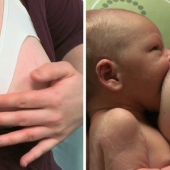It can help to learn about the different types of breast milk, how it changes over time and even through a feed. The very first milk you produce just after birth is called colostrum. Many moms with colostrum worry that it doesn't seem like there's lots. It's really important to remind yourself that it's concentrated milk and it's perfect for your baby, and the small amount is just right for the baby, and it needs its food in concentrated amounts.
Quickly the amount of milk that you make for your baby will start to increase. The more times you feed the baby, the more signals you'll give to your body to make milk, and the milk will change from that colostrum, or really concentrated milk, to breast milk, which is a bit more watery and bigger in quantity.
When does that change happen then, from colostrum to mature milk? It's gradual, but what moms will notice is it's round about the third day after they've had their baby, third, fourth day, their breasts starting to feel heavier and they can really know something's going on.
They look slightly bigger and they feel fuller, and that's really the milk production beginning to kick off. If the moms don't experience that change, that fullness with the milk coming in at around that third and fourth day, because sometimes it takes a little bit longer, then it's important not to worry because worrying doesn't help, but it is important to check out with your midwife on how things are going.
The baby having lots of feeds is what tells the body to make milk, and sometimes the babies are a bit sleepy, or born a little bit early and they don't quite know almost to do that for themselves, so they need a little bit of a nudge.
It is important that the babies get these frequent feeds early to get everything going and if things just seem a little bit slow, then it's not a reason for panic, but it is a reason to check, "Is there anything else that we can be doing to help make sure that this all goes well?"
Breast milk is such fascinating stuff and it changes through the feed. At the beginning of the feeds, the milk is more like a drink. It's got lots of goodness in it still and it has got fat in it, but it's lower in fat than towards the end of the feed, and that's purely to do with physics really, the mechanics.
As the feed goes on, and the little muscles, that are in your breasts, are pushing the milk down towards the baby, squeeze tighter, the feed gets richer and richer in fat toward the end.
It's really important to make sure that you follow your baby and let the feed last for as long as the baby wants because if you are looking at your watch and decide after 20 minutes the baby had enough, it might just miss the very richest bits.
Some people like to call it the pitting of the breast feed, the very richest bit, which is highest in fat and, of course, as high in fat, it will help the baby put on weight and also keep the baby fuller for longer. It's like if you have a three course dinner and a pudding with cream on top. It keeps you full for a long time.
Another thing about the foremilk and hindmilk is sometimes because moms understand that and understand it's important for the baby to get the hindmilk, then they worry about how they know the baby's getting the hindmilk. As long as you follow your baby and you make sure the baby feeds for as long as the baby wants to, as long as the baby's feeding effectively, then really you can trust that the baby will be getting the hindmilk.
Another thing is the way that the rhythm of the baby suckling at the breast changes slightly differently. If we talk through the breast feed, at the beginning of the feed, the suckling of the baby is quite quick and it's saying to the breast, "I'm here. Let the milk flow."
Then the milk starts to flow and the baby goes into a lovely sucking rhythm where it's quite long and slow and they will have little pauses, and then off it'll go again, nice, slow, deep sucking rhythm.
Then towards the end of the feed, the baby does tiny little sucks that are quite fluttery and sometimes the moms will misinterpret that and think, "The baby's just messing around a little bit," but actually those little flutter sucks are really clever at getting that really thick milk at the end, the fat, rich milk. So look for those little flutter sucks, and if the baby's been doing those, then you know that it's at the hindmilk.
- 4161 views













